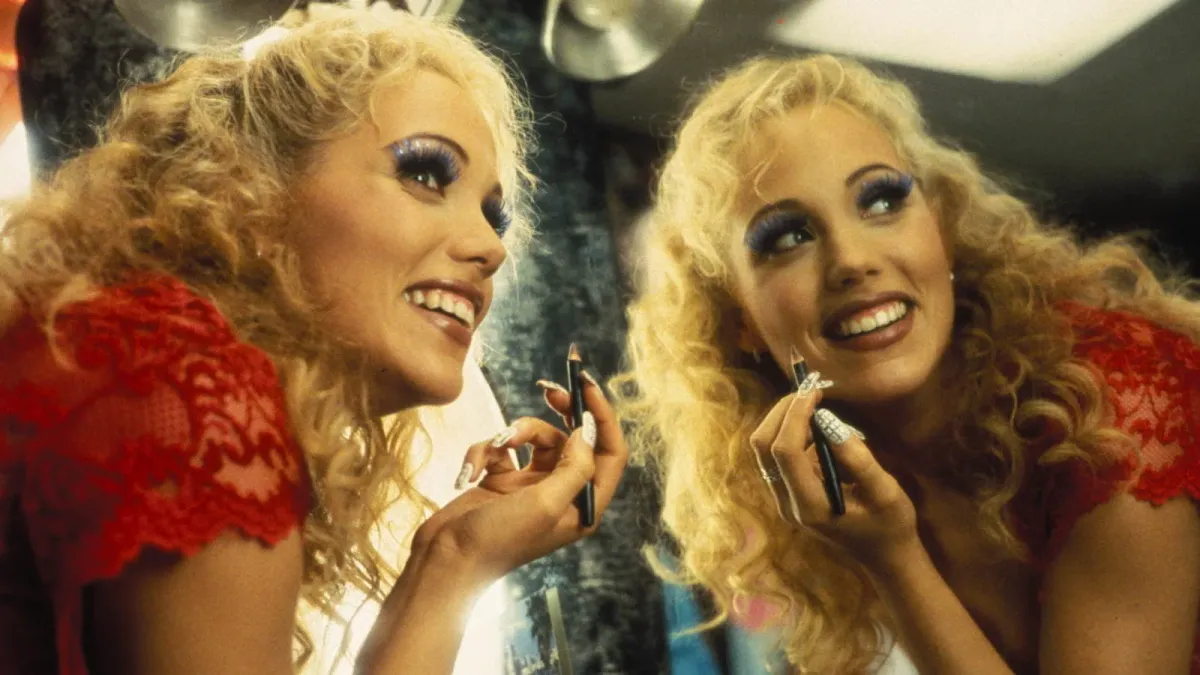A unified theory of Showgirls

SHOWGIRLS IS BAD. This is close to a universally accepted truth. Much has written about how and why Paul Verhoeven’s 1995 stripper saga is bad. Some say it’s quite simply astoundingly bad; some argue its badness is an isotope of exotic camp worthy of cult-movie status; others make the case that the film is a highly modulated satire whose badness is part of its stinging commentary.
I’ve never found these statements satisfactory. They certainly describe the range of possible intentions behind the film’s badness, but, to me, they fail to sufficiently account for Showgirls’ uniquely uncanny and often nonsensical badness. The apparent badness of Showgirls is exceptional in how it seems to wildly overshoot the heuristic aims of camp or satire. If you’ve seen the movie, you know what I mean. Showgirls has a charged, glossy cheapness to it, and there’s a strenuous, hyperbolic quality to the dialogue and acting that suggests the lurking presence of a Potemkin facade. It’s so overwrought with a fugitive … something.
I think I finally understand what it is. To mark the 30th anniversary of the film’s release, I propose a new theory that explains Showgirls. My theory determines that Showgirls is bad because it’s actually really good. Admittedly, my theory is insane.
Showgirls is a work of science fiction. Protagonist Nomi Malone — ostensibly a drifter with a mysterious past who winds up in Vegas — is a robot. Specifically, she is an advanced prototype of a sentient android whose misadventures in Las Vegas are part of an open-ended beta test. On a general level, the carbonated drama and histrionic tics of Showgirls are much more legible, coherent, satisfying, and even pleasing when you think about the movie in this theoretical framework. On a more granular level, this theory, I hope, offers cogent explanations for the film’s many baffling — and sometimes even surreal — scenes.
Consider just a few of Nomi’s most celebrated (read: ridiculed) moments that suggest not overacting or bad directing but, instead, the unsubtle operations of a machine consciousness: Nomi violently flailing like a malfunctioning droid in the pool sex scene with Zack Carey (Kyle MacLachlan); or her precisely (algorithmically?) naive mispronunciation of “Versace” as “Ver-SAYS”; or her whipping out a switchblade with almost heartbreakingly radiant, theatrical menace on the rando with the Elvis mullet who gives her a ride into Vegas at the beginning of the film — a rando who, I should point out, conveniently picks her up at film’s end to whisk her away … hmm … as though he’s in charge of Nomi-bot’s initial deployment and post-mission debriefing. It’s one of Showgirls’ many ridiculous coincidences that, according to my theory, are actually ridiculously intentional.
The film is notoriously rife with scenes that are stunningly awkward, and involve such improbable character interactions that they make the best sense with the Nomi Malone robot theory. Take, for example, Nomi’s tête-à-tête with her dance rival Cristal Connors over a champagne lunch at Spago. It ostensibly aims to be a scene smoldering with arch, mutual fascination, envy, and a kind of erotic gamesmanship. That is, until their conversation about dancers’ diets leads to Cristal confessing, “I used to eat dog food … I used to love doggy chow.” To which Nomi says brightly, “I used to love doggy chow too! ” — while eerily mirroring Cristal’s movements (warning: language):
Sure, perhaps they were bonding over past poverty or heroin abuse (“dog food” is said to be slang for heroin), but I can’t help but think Cristal’s odd declaration and studious attention to Nomi’s responses suggest that Cristal, among others, is monitoring the android’s behavioral repertoire. This suffuses the entire film — stilted, florid acting that’s a little too stilted and florid; dialogue so studded with non-sequiturs that conversations play out like some kind of hard-boiled dadaist performance; in every scene, the furtive, knowing glances between Nomi’s friends, rivals, and fellow dancers that glimmer with an awareness of the whole meta of the situation and evoke nothing so much as the bemusement of scientists. Are they marveling over Nomi’s naiveté, Nomi’s boldness, Nomi’s talent? Or are they marveling at a replicant’s emerging sentience and emotional development?
I propose that Nomi Malone’s (no-me, I’m-alone) distinctly primitive, violent range of emotion — childlike glee to glowering rage — is a record of her entrainment to becoming more humanlike. Her human beta-testers, on the other hand — leaning into their roles with swerving momentum as though performing at a theme park — are acting like humans instructed to act like humans for the benefit of a cyborg debutante’s sentimental education. Showgirls is a terrible erotic drama because in actuality it’s really good sci-fi.
I submit as supporting evidence that Showgirls is bookended by a few other notable Paul Verhoeven works that could arguably all be part of the same imagined universe: Robocop (1987), Total Recall (1990), and Starship Troopers (1997).
Showgirls isn’t a latter-day All About Eve. It’s a prequel to Westworld. ✦





